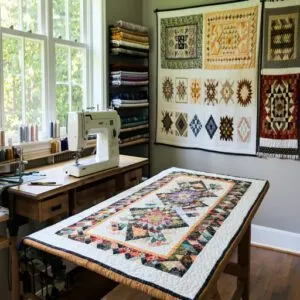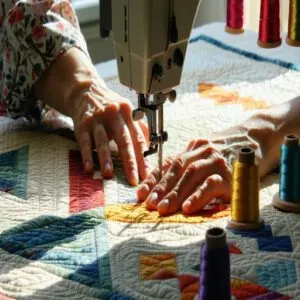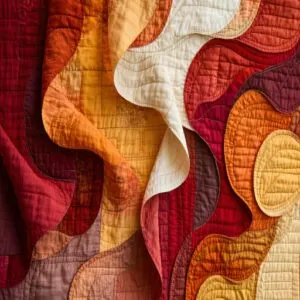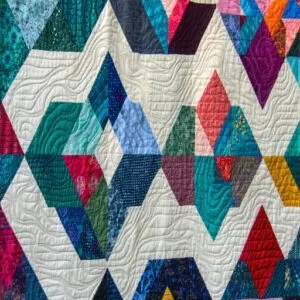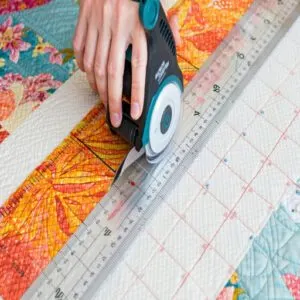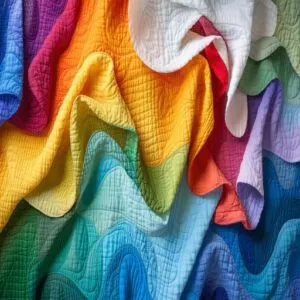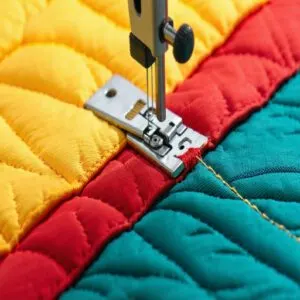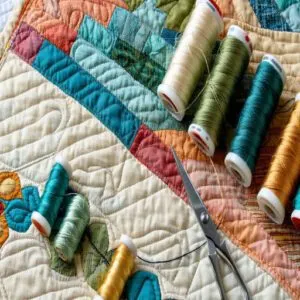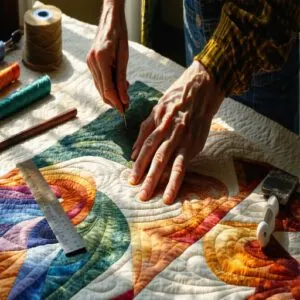This site is supported by our readers. We may earn a commission, at no cost to you, if you purchase through links.
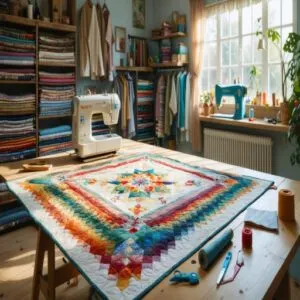
These tips for advanced quilting techniques will transform your projects into masterpieces.
Start with foundation paper piecing for precise geometric designs, then express your creativity with free-motion quilting.
You’ll want to invest in quality tools – a sharp rotary cutter and walking foot are your new best friends.
Layer and overlap fabrics to add stunning depth, and don’t shy away from improv piecing when you’re feeling adventurous.
Remember, even seasoned quilters started somewhere – practicing patience and breaking down complex techniques into bite-sized pieces leads to show-stopping results.
The secrets to perfect seams and flawless corners await.
Table Of Contents
Key Takeaways
- Practice foundation paper piecing for precise geometric designs and layered depth in your quilting projects.
- Use quality tools like a sharp rotary cutter and a walking foot to ensure smooth, accurate stitching and professional results.
- Experiment with free-motion quilting and improv piecing to express creativity and add unique personality to your designs.
- Perfect your appliqué techniques and focus on mastering seam allowances for clean, polished, and intricate patterns.
Essential Quilting Techniques
Mastering essential quilting techniques, like appliqué and foundation paper piecing, sets the stage for truly stunning designs.
These methods challenge your skills while opening up creative possibilities to bring your vision to life with foundation paper piecing.
Appliqué Methods
Appliqué techniques take practice, but they’re worth it.
Mastering methods like needleturn appliqué gives you precise stitch control for intricate designs.
Prefer machines? Try machine appliqué or decorative stitches like the double blanket stitch for bold edges.
For raw edge appliqué, sharp fabric cutting creates clean shapes.
These appliqué tips transform simple fabrics into striking, layered pieces with personality!
Improv Piecing Approach
Ever tried improv piecing? It’s the jazz of quilting techniques—no rules, just spontaneity.
Start with a bold color palette selection, then plunge into fabric scrap management to create patchwork quilting magic.
Layer, trim, and let mistakes guide your spontaneous design, which involves textile experimentation that keeps things fresh, offering creative freedom that turns "oops" moments into uniquely stunning quilts.
Foundation Paper Piecing
Foundation paper piecing lets you craft intricate designs with stitch-perfect accuracy.
Start by selecting lightweight paper foundations and prepping your fabric with precision.
Choose patterns with crisp geometric shapes to hone your skills.
Focus on each step—paper selection, consistent stitching, and careful block assembly.
Mastering hand quilting techniques is also essential for achieving professional-looking results.
This advanced quilting technique thrives on practice, turning patchwork quilting into stunning, polished creations.
Advanced Quilting Methods
You’re ready to take your quilting skills to the next level with advanced techniques that add precision and creativity.
From intricate geometric patterns to layered fabric art, these methods will transform your projects into masterpieces.
Free Motion Quilting
Free motion quilting lets you break free from rigid patterns and express creativity.
Focus on stitch control by balancing hand movements and speed. Adjust thread tension and machine calibration to avoid mishaps.
To improve your skills, consult a free motion guide for expert advice.
Experiment with quilt density to achieve desired texture and fabric draping. Master these advanced quilting techniques with practice, using proper quilting tools to elevate your sewing techniques.
Layering and Overlapping Fabrics
When tackling advanced quilting techniques, layering and overlapping fabrics bring stunning results.
Cut your backing and batting larger than your quilt top for stability. Smooth everything out and secure layers with pins or spray.
Overlapping fabrics add visual depth and texture creation, while fabric selection guarantees seamless blending. For more on quilt layering techniques, consider the importance of proper layer preparation.
Start quilting from the center outward, avoiding puckers.
Geometric Shape Designs
Adding geometric shapes to your quilting designs brings bold symmetry patterns and modern flair.
Play with angular designs and creative shape combinations like hexagons, triangles, or diamonds. Precision sewing guarantees sharp edges and intricate designs.
Experiment with spatial arrangements to highlight geometric accents. These advanced quilting techniques make each project a masterpiece, transforming basic quilts into eye-catching, structured works of art.
Quilting Tools and Materials
The right tools and materials can transform your quilting experience, making even intricate techniques easier and more enjoyable.
From sharp rotary cutters to quality fabrics and trusty walking feet, it’s all about working smarter, not harder.
Rotary Cutter Usage
A rotary cutter is your secret weapon for cutting accuracy.
Pair it with an acrylic ruler and a self-healing mat for straight, precise slices.
Keep blades sharp—dull ones ruin fabric and your patience.
Handle the tool firmly, with cutting safety in mind.
Prep fabric by ironing wrinkles out first.
For best results, using sharp Rotary blades is essential.
Mastering rotary cutting? It’s sharp skills, not just sharp blades!
Quality Fabric Selection
Rotary cutters are amazing, but without the right fabric, even the sharpest blades can’t save a project.
Stick to 100% cotton fabrics with tight weaves for durability. Play with color theory and texture mixing to make designs pop. Avoid fabric chaos—match weights for smooth sewing. Remember, a bold “zinger” color can elevate your quilting fabric game.
For the best results, invest in high-quality Cotton Quilting to guarantee your projects turn out beautifully.
- Choose tight-weave, quilt-quality fabrics.
- Stick to 100% cotton for consistency.
- Pre-wash to prevent surprises.
- Stick to similar fabric weights.
- Add pops of bold color.
Walking Foot Benefits
A walking foot, often called an Even Feed foot, upgrades your sewing machine game.
It guarantees smooth stitching, perfect fabric control, and seamless tension adjustment.
From quilting techniques to advanced sewing tips, it’s essential for tackling bulky layers without hassle.
If thread management frustrates you, this tool keeps layers aligned effortlessly.
Understanding the walking foot benefits is vital for mastering various sewing projects.
| Benefit | What It Does | Why It Matters | Tip |
|---|---|---|---|
| Smooth Stitching | Glides layers together | Avoids puckering | Use for thicker projects |
| Fabric Control | Prevents fabric shifting | Keeps quilting precise | Perfect for strips and grids |
| Tension Adjustment | Balances top and bottom | No skipped stitches | Practice on scrap fabric first |
| Thread Management | Maintains proper feeding | Clean, tidy stitches | Adjust thread tension slightly |
Troubleshooting Common Mistakes
Even experienced quilters run into snags, but knowing how to fix them can save time and frustration.
From skipped seams to uneven blocks, you’ve got this with a few simple adjustments.
Avoiding Pinning Errors
Pinning can feel like a prickly chore, but smart alternatives make quilting smoother.
Try these:
- Spray Basting: A quick fix for layer stability.
- Fabric Adhesives: Keep pieces in place without punctures.
- Basting Stitches: Easy to remove and foolproof.
- Thread Basting: Great for high-stress areas.
- Pin Basting Mats: For secure, even tension.
Skip the pins, embrace control!
Efficient Triangle Cutting
Cutting triangles accurately is essential for sharp corners and smooth seams.
Use rotary cutters and follow cutting instructions to minimize fabric waste.
Add extra fabric when cutting and trim after sewing for precise corner alignment.
Experiment with quilting techniques like foundation paper piecing to sharpen your skills.
Maintaining seam efficiency guarantees your sewing techniques stay polished and consistent throughout projects.
Seam Allowance Guidelines
Don’t underestimate seam allowance—it’s your secret weapon for stitch accuracy and avoiding cutting mistakes.
Stick to the trusty 1/4-inch margin for most quilting techniques, and double-check your sewing directions for consistency.
Remember, fabric shrinkage can throw off precision, so pre-wash everything.
Mastering margin control guarantees flawless results, whether you’re tackling foundation paper piecing or other advanced sewing techniques.
Mastering Quilting Skills
Mastering quilting skills takes dedication, but breaking it down into manageable steps makes the process rewarding. Start with small projects, combine techniques, and focus on precision to achieve beautiful results.
Starting Small Projects
When mastering quilting techniques, starting with manageable projects builds confidence.
Small blocks and beginner projects like quilted gifts make great practice.
- Try quilting kits for easy-to-follow patterns.
- Focus on precise fabric selection to create harmony.
- Experiment with foundation paper piecing.
- Create mini table runners or coasters.
Use small projects to experiment without stress, refining advanced quilting skills effortlessly, which helps in mastering quilting techniques.
Combining Techniques
Mix up your quilting techniques by pairing foundation paper piecing with Stitch Combos or Fabric Blending for striking designs.
Add Quilt Layering to increase depth, and try Texture Mixing with threads for dimension.
Advanced quilting shines when combining techniques like mixed media or appliqué. These quilting tips create stunning, personalized designs, making every quilt a masterpiece of blended creativity.
Practicing Patience and Precision
Adding multiple quilting techniques to a single project might feel overwhelming, but patience is your best tool.
Slow your quilting pace to master stitch control and thread management. Check fabric tension regularly to avoid puckering.
Developing sewing lessons helps quilters refine their skills over time.
Precision comes with practice, so embrace small missteps as learning opportunities. Correcting errors early guarantees precise designs that truly shine.
Frequently Asked Questions (FAQs)
What is the golden rule in quilting?
You’ll move mountains when you measure twice and cut once – it’s the quilter’s golden rule.
Always double-check your measurements and fabric alignments before making any cuts to prevent costly mistakes.
What is the magic 8 method in quilting?
The Magic 8 method creates eight identical half-square triangles from two fabric squares.
You’ll draw diagonal lines, stitch around the perimeter, and make precise cuts that transform simple squares into perfectly matched triangles.
This process allows for the creation of perfectly matched triangles from simple squares.
What are the 3 different techniques used in quilting?
Like a well-orchestrated symphony, quilting dances with three main techniques
The techniques include patchwork for joining fabric pieces, appliqué for adding decorative elements, and quilting itself – the process of stitching layers together for beautiful dimension.
Do you start in the middle when machine quilting?
Starting in the middle when machine quilting helps prevent fabric bunching and guarantees even tension.
You’ll want to work your way outward in sections, smoothing as you go for professional-looking results.
How to match thread tension for different fabric weights?
You’ll need to test your thread tension on a scrap piece of fabric first.
Adjust the upper tension dial in small increments until stitches look balanced – no loops on top or bottom.
When should quilters upgrade their sewing machine?
Upgrade your sewing machine when it struggles with thicker fabrics, advanced techniques, or precision stitching.
If tension issues, skipped stitches, or limited features slow you down, investing in a modern, reliable machine can save time and frustration.
Best ways to store unfinished quilting projects?
A stitch in time saves nine—store unfinished quilts in clear bins or bags to keep them dust-free.
Label each project, include notes on progress, and keep them within easy reach to stay inspired and organized.
How to join batting pieces for oversized quilts?
Stitch batting pieces together using a zigzag or ladder stitch for a secure, flat seam.
Overlap edges slightly, trim any excess, and avoid puckering.
It’s an easy way to handle oversized quilts without wasting material.
Recommendations for quilting with metallic or specialty fabrics?
Work slowly with metallic fabrics.
Use sharp needles, lower your machine tension, and pair lighter threads to avoid snagging.
A pressing cloth helps prevent scorch marks, and stabilizers keep shifts in check for a polished finish.
Conclusion
Mastering advanced quilting techniques isn’t magic—it’s practice, patience, and a little trial-and-error (with some seam-ripping thrown in).
By diving into skills like foundation paper piecing, free-motion quilting, and bold improv piecing, you’re stepping up your creative game.
Invest in tools that make your life easier, like a sharp rotary cutter or a trusty walking foot, and troubleshoot mistakes as opportunities to learn.
With these tips for advanced quilting techniques, your projects will go from impressive to jaw-dropping in no time.
- https://quiltdom.com/quilting-tips/
- https://www.nationalquilterscircle.com/post/top-10-quick-quilting-tips
- https://www.thesprucecrafts.com/skills-every-beginning-quilter-should-master-2821882
- https://www.quiltingdaily.com/technique/
- https://quilting.wonderhowto.com/how-to/use-advanced-quilting-techniques-228513/

